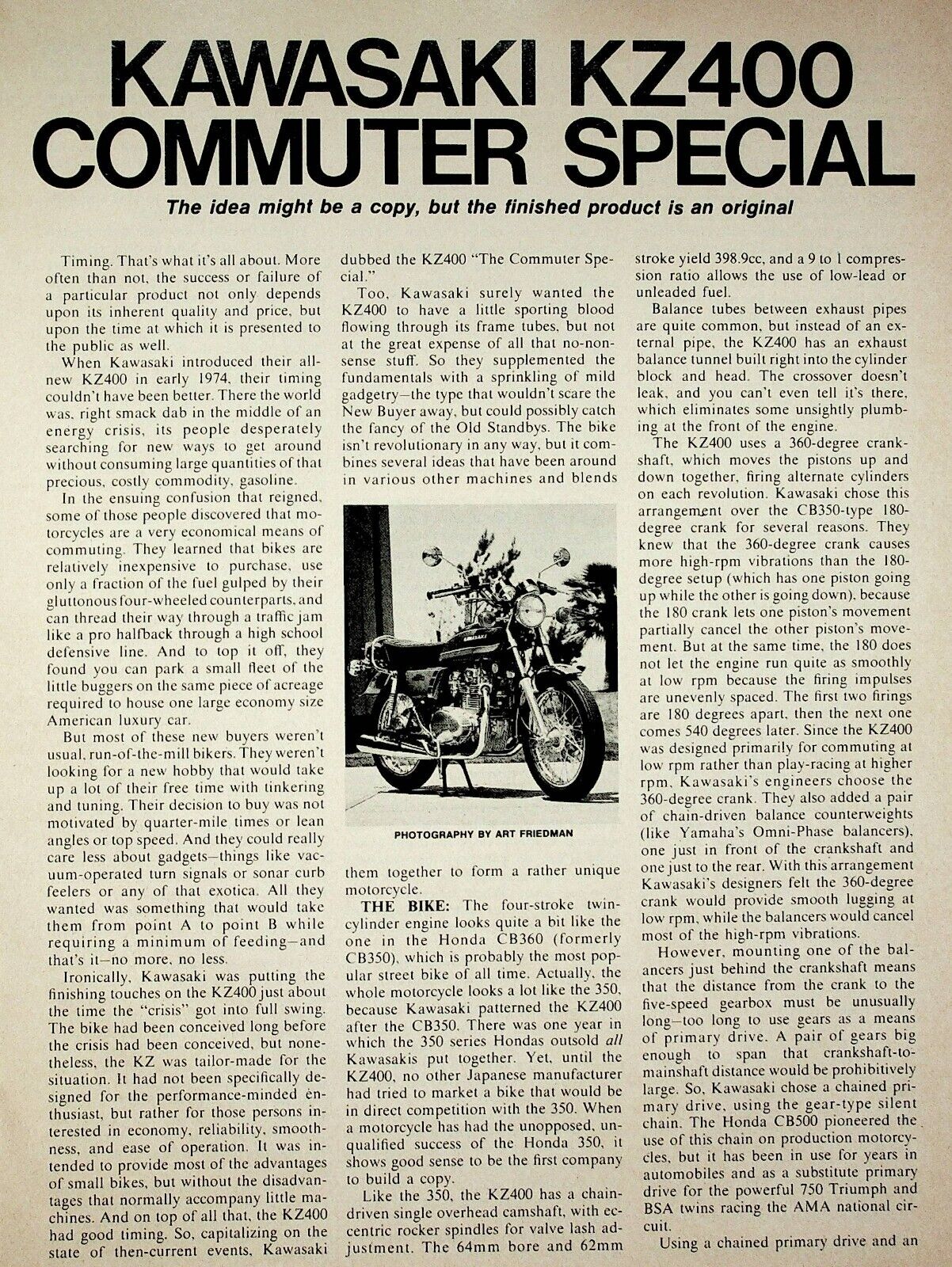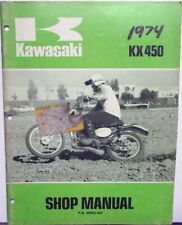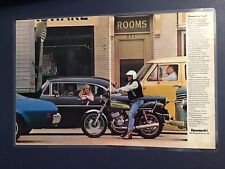1974 Kawasaki KZ400 Commuter Special - 6-Page Vintage Motorcycle Article For Sale

When you click on links to various merchants on this site and make a purchase, this can result in this site earning a commission. Affiliate programs and affiliations include, but are not limited to, the eBay Partner Network.
1974 Kawasaki KZ400 Commuter Special - 6-Page Vintage Motorcycle Article:
$11.39
Yes we combine shipping for multiple purchases.Add multiple items to your cart and the combined shipping total will automatically be calculated.1974 Kawasaki KZ400 Commuter Special - 6-Page Vintage Motorcycle Article
Original, vintage magazine article.Page Size: Approx. 8" x 11" (21 cm x 28 cm) each pageCondition: Good
KAWASAKI KZ400COMMUTER SPECIALThe idea might be a copy, but the finished product is an originalTiming. That's what it’s all about. Moreoften than not, the success or failure ofa particular product not only dependsupon its inherent quality and price, butupon the time at which it is presented tothe public as well.When Kawasaki introduced their all-new KZ400 in early 1974, their timingcouldn't have been better. There the worldwas. right smack dab in the middle of anenergy crisis, its people desperatelysearching for new ways to get aroundwithout consuming large quantities of thatprecious, costly commodity, gasoline..In the ensuing confusion that reigned,some of those people discovered that mo-torcycles are a very economical means ofcommuting. They learned that bikes arerelatively inexpensive to purchase, useonly a fraction of the fuel gulped by theirgluttonous four-wheeled counterparts, andcan thread their way through a traffic jamlike a pro halfback through a high schooldefensive line. And to lop it off, theyfound you can park a small fleet of thelittle buggers on the same piece of acreagerequired to house one large economy sizeAmerican luxury car.But most of these new buyers weren’tusual, run-of-the-mill bikers. They weren'tlooking for a new hobby that would lakeup a lol of their free time with tinkeringand tuning. Their decision to buy was notmotivated by quarler-mile times or leanangles or lop speed. And they could reallycare less about gadgets—things like vac-uum-operated turn signals or sonar curbfeelers or any of that exotica. All theywanted was something that would lakethem from point A to point B whilerequiring a minimum of feeding—andthat’s it—no more, no less.Ironically. Kawasaki was pulling thefinishing touches on the KZ400 just aboutthe lime the “crisis” got into full swing.The bike had been conceived long beforethe crisis had been conceived, but none-theless. the KZ was tailor-made for thesituation. It had not been specifically de-signed for the performance-minded en-thusiast, but rather for those persons in-terested in economy, reliability, smooth-ness, and ease of operation. It was in-tended to provide most of the advantagesof small bikes, but without the disadvan-tages that normally accompany little ma-chines, And on top of all that, the KZ400had good timing. So. capitalizing on thestate of then-current events. Kawasakidubbed the KZ400 “The Commuter Spe-cial.”Too. Kawasaki surely wanted theKZ400 to have a little sporting bloodflowing through its frame tubes, but notat the great expense of all that no-non-sense stuff. So they supplemented thefundamentals with a sprinkling of mildgadgetry—the type that wouldn’t scare theNew Buyer away, but could possibly catchthe fancy of the Old Standbys. The bikeisn’t revolutionary in any way. but it com-bines several ideas that have been aroundin various other machines and blendsPHOTOGRAPHY BY ART FRIEDMANthem together to form a rather uniquemotorcycle.THE BIKE: The four-stroke twin-cylinder engine looks quite a bit like theone in the Honda CB360 (formerlyCB35O). which is probably the most pop-ular street bike of all time. Actually, thewhole motorcycle looks a lot like the 350.because Kawasaki patterned the KZ400after the CB350. There was one year inwhich the 350 series Hondas outsold allKawasakis put together. Yet. until theKZ400, no other Japanese manufacturerhad tried to market a bike that would bein direct competition with the 350. Whena motorcycle has had the unopposed, un-qualified success of the Honda 350, itshows good sense to be the first companyto build a copy.Like the 350. the KZ400 has a chain-driven single overhead camshaft, with ec-centric rocker spindles for valve lash ad-justment. The 64mm bore and 62mmstroke yield 398.9cc, and a 9 to 1 compres-sion ratio allows the use of low-lead orunleaded fuel.Balance lubes between exhaust pipesare quite common, but instead of an ex-ternal pipe, the KZ400 has an exhaustbalance tunnel built right into the cylinderblock and head. The crossover doesn'tleak, and you can’t even tell it's there,which eliminates some unsightly plumb-ing al the front of the engine.The KZ400 uses a 360-degree crank-shaft. which moves the pistons up anddown together, firing alternate cylinderson each revolution. Kawasaki chose thisarrangement over the CB35O-lype 180-degree crank for several reasons. Theyknew that the 360-degree crank causesmore high-rpm vibrations than the 180-degree setup (which has one piston goingup while the other is going down), becausethe 180 crank lets one piston’s movementpartially cancel the other piston’s move-ment. But at the same time, the 180 doesnot let the engine run quite as smoothlyat low rpm because the firing impulsesare unevenly spaced. The first two firingsare 180 degrees apart, then the next onecomes 540 degrees later. Since the KZ400was designed primarily for commuting atlow rpm rather than play-racing at higherrpm. Kawasaki's engineers choose the360-degree crank. They also added a pairof chain-driven balance counterweights(like Yamaha’s Omni-Phase balancers),one just in front of the crankshaft andone just to the rear. With this arrangementKawasaki’s designers felt the 360-degreecrank would provide smooth lugging allow rpm. while the balancers would cancelmost of the high-rpm vibrations.However, mounting one of the bal-ancers just behind the crankshaft meansthat the distance from the crank to thefive-speed gearbox must be unusuallylongMoo long to use gears as a meansof primary drive. A pair of gears bigenough to span that crankshaft-to-mainshaft distance would be prohibitivelylarge. So, Kawasaki chose a chained pri-mary drive, using the gear-type silentchain. The Honda CB500 pioneered theuse of this chain on production motorcy-cles, but it has been in use for years inautomobiles and as a substitute primarydrive for the powerful 750 Triumph andBSA twins racing the AMA national cir-cuit.Using a chained primary drive and...
15936

Related Items:
1974 Kawasaki KX450 Motorcycle Shop Manual
$44.00
1974 Kawasaki H2B Mach IV Triple Original 11x17 laminated ad
$13.50
1974 Kawasaki KZ400 Commuter Special - 6-Page Vintage Motorcycle Article
$13.02



